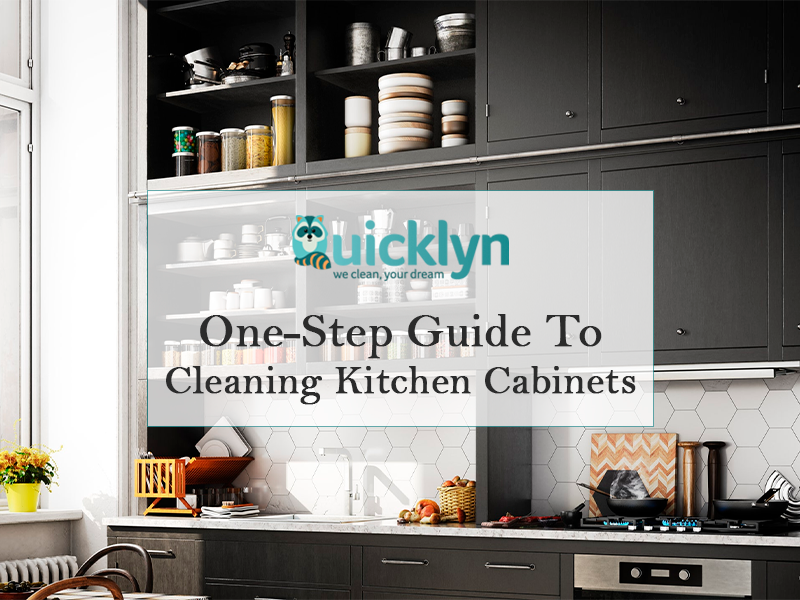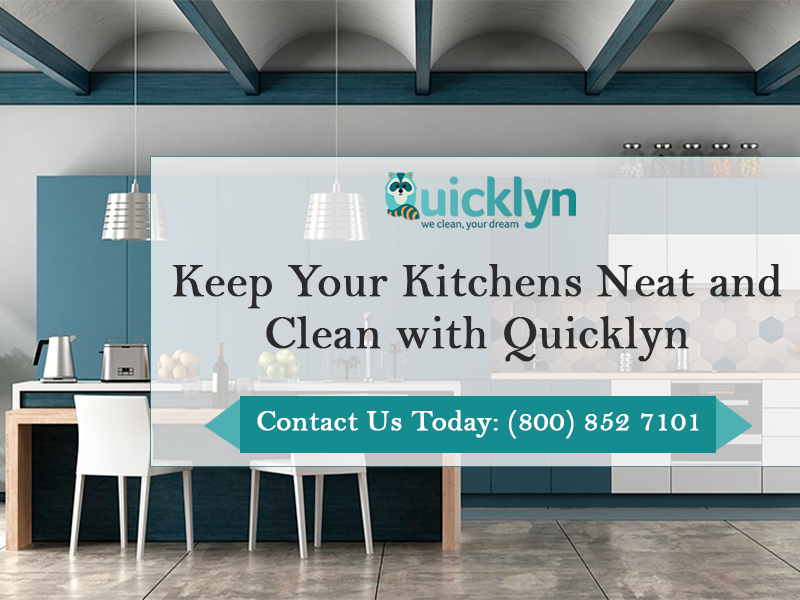One-Step Guide To Cleaning Kitchen Cabinets

If you are fond of cooking and spending time in the kitchen, you’ll also have to brace yourself for the eventuality of spills, splatters, and grease accumulating on your cabinets and cupboards. This will, in turn, warrant a good cleaning session, one that’s a bit more thorough than the usual quick daily wipe-down of the stove, counters, and tabletops.
The Challenges of Cleaning Kitchen Cabinets
It is no secret that kitchen cabinets go through a lot. From suffering accidental spills to falling victim to cooking splatters, and getting sullied by a continuous barrage of fingerprints; it is as if the entire universe is conspiring against their cleanliness and hygiene. Despite this, those hardworking uppers and lowers tend to get neglected during regular weekly cleaning. As a result, by the time you realize this, grease, grime, dirt, and smears may have already registered a significant build-up on them. This is not merely unsightly, but also largely insanitary. Frequently handled cabinet hardware can play host to a variety of germs, and food crumbs hiding in back corners can invite bugs and vermin. To complicate things further, kitchen cabinets come in various makes, which means the cleaning tips can’t necessarily hold true for the other.
Taking that into account, in this article, we’ve discussed how to clean some of the most common materials, like natural and painted wood, laminate, metal, and glass. Additionally, we also share a few highly effective cleaning methods for tackling the worst in terms of accumulated kitchen grunge – the hidden tops of cupboards. Of course, if you want to hand over this job to experts, look no further than Quicklyn. Our extremely pocket-friendly cost of cleaning service coupled with our accomplished and vetted cleaning professionals makes us one of the most cherished professional cleaning services in NYC.
Getting The Basics Right
Before we dive deep into material-wise cleaning tips, let us first go through some basic kitchen cabinet cleaning tips that can apply to all. Read on to find out!
Dusting
Dusting your kitchen cabinets daily can spare you the trouble of scheduling an intensive cleaning for your kitchen cabinets. It may seem a bit unreasonable to dust vertical surfaces, but dust will accumulate on cupboard exteriors, especially if you do a lot of frying in your kitchen. Fine particles of oil will settle on all surfaces, including vertical ones. In subsequent times, they act as dust magnets. Regular dusting with a lint-free cloth or duster prevents this combination of oil and dust from forming that stubborn and hard-to-remove layer of residue.
Washing With Soap and Water
Most of the spots and smears that appear on cupboard exteriors on a daily basis can be dealt with merely by using a soft cloth and warm, soapy water. However, when it comes to tough stains and stubborn grease layers, a bit of extra elbow grease might be necessary. To wash with soap and water, it is advisable that you use a mild detergent. To start the cleaning process, first soak and wring out the cloth. Then, proceed with wiping all the surfaces thoroughly. Pay extra attention to handle, hinges, and any surface ridges that form design details. For hard-to-remove layers of grime and grease, use a solution of white vinegar and hot water. All you need to do is add one cup of vinegar to two cups of hot water. Once the solution is ready, take a clean cloth and soak it in this solution. Wring it out, and wipe down your greasy cabinets. Dry with a soft cloth.
And even if this solution fails to work its charm, then make a paste of white vinegar and baking soda. Take a clean and soft cloth, rinse it with warm water, and wring out the excess moisture. Then, pick up some of the paste and dab it on wherever it’s needed. Allow it to rest on the surfaces for a few minutes. Rub gently with a damp cloth or the textured side of a sponge to lift the grime. Alternatively, you can also use a soft-bristled brush. To cope up the process, rinse with clear water and dry with a clean cloth.
Cleaning Tips For Different Kinds of Kitchen Cabinet Materials
Wood
Most wood finishes can be cleaned in the same manner, without having to shell out money for expensive specialty products. General-purpose oil and soap cleaners prove to be highly effective when it comes to cutting through grease and stains on wood cupboards However, they also have a tendency to leave a sticky residue behind. Subsequently, this residue ends up becoming a natural trap for dust.
For regular washing, you can consider using a soft sponge or cloth soaked in a solution of warm, soapy water. Rinse promptly with clear water, then dry with a soft cloth. On the other hand, if you have to remove layers of sticky grim and grease, you may need to go with a natural citrus cleaner, such as lemon or orange oil.
Oil-based Paint
Cabinets coated with oil-based paint can be cleaned using a soft nylon brush. A word of caution; avoid applying nylon brushes on latex and chalk paints for the scrubbing may result in the paint lifting or peeling. The most effective method of cleaning painted cupboards involves using a mixture of mild liquid dish detergent and warm water. Oil-painted cabinets can also take scrubbing with ammonia and hot water.
Metal
Metal cabinets usually have an enamel finish, so you can concoct a solution of water and liquid dish soap to keep it stain and grease-free. Should the washing with warm, soapy water and a soft sponge, prove to be ineffective, you can consider using rubbing alcohol to deal with the grime and grease.

Keep Your Kitchens Neat and Clean with Quicklyn
Quicklyn’s vast suite of apartment carpet cleaning services, as well as deep cleaning maid services in New York, helps you find housemaids and provides you with top-notch cleaning options that take the burden of cleaning the house completely off your shoulders. Our hand-selected team of professional cleaners and luxury maid service are always ready to keep your home looking, smelling, and feeling fresh.


